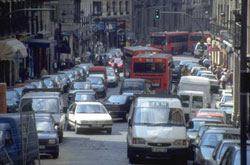|

London's
"red" mayor, Ken Livingston, was widely
believed to have gone "too far" a year ago
when he announced a plan
to hit commuters with a special congestion charge every
time they entered the central city.
The £5 ($8.90) charge was reviled by the business
community at the time, and the opposition Tories still
hate it. Conservative Party Shadow Transport Minister
Damian Green opined, "The [London] Government has
spent seven years waging war on motorists. A
Conservative government would reverse that with a range
of practical policy changes. We recognize that for tens
of millions of people driving a car is a necessity, and
should not be made a misery by government policy. We
will be the intelligent friend of the safe and sensible
driver." Whole forums
are still devoted to attacking the congestion charge.

But
guess what? I've been to London, and I've seen how
miserable the traffic can be. I've spent hours inching
along in bumper-to-bumper gridlock worse than anything
I've ever seen in downtown Manhattan. Before the
congestion charge, average traffic speed had fallen
below three miles per hour in the city.
Livingston's
modest goal in implementing the charge was to cut
congestion by 15 percent and raise £130 million ($232
million) annually to help support the city's public
transit. Commuters are allowed to pay (in daily to
annual installments) by telephone, by text message, by
mail, through the Internet or in person at a retail
outlet.
And
guess what again? It works! According to the July/August
issue of Britain's Green
Futures magazine, congestion is actually down 30
percent in the downtown zone. And there's more:
•
Drivers spend up to a third less time sitting at a
standstill or crawling slowly along;
•
Drivers make some 65,000 to 70,000 fewer trips per day;
•
Some 50 to 60 percent of drivers are choosing public
transportation rather than diverting around the zone or
driving their cars at odd hours (the zone is active
Monday to Friday, 7 a.m. to 6:30 p.m.);
•
Bus speeds have climbed six percent, ridership is up 38
percent, and interruptions to travelers' journeys are
down 60 percent.
•
The air is getting cleaner. In the city once famous for
coal-fired "fogs," there has been a 12 percent
reduction in nitrogen oxide emissions and diesel-related
"particulates." The main greenhouse gas,
carbon dioxide, has been cut 19 percent.
London
is not the only city to try this form of congestion
pricing, which in the U.S. has mainly appeared in the
form of a few turnpikes with variable toll amounts that
are highest during rush hours. In Trondheim, Norway,
drivers pay 15 kroner ($1.60) to visit the downtown
area, and trucks pay double. The walled cathedral city
of Durham, England collects £2 ($3.50) from motorists
who come to see the historic cathedral and castle.
Edinburgh, Scotland is considering a £2 charge.
Meanwhile,
in the U.S. we're bogging down in endless traffic, with
no end in sight and a complete vacuum of leadership from
the federal government. I wrote an entire book
on the subject, Breaking Gridlock. A new study,
the Texas Transportation Institute's annual Urban
Mobility Report, concludes that commuters are losing 3.5
billion hours to congestion every year, up from just 700
million 20 years ago. As of 2002, the average urban
commuter spent 46 hours a year stuck in traffic,
compared to 16 hours in 1982. To find out the grim news
about your own region, click
here.
I
took a look at New Haven, Connecticut, which has had
only modest population increases since 1982. But freeway
miles traveled have jumped from five million 20 years
ago to 7.5 million today. Annual delays tripled. The
average New Haven commuter lost nine hours in 1982 and
22 hours in 2002. New Haven commuters used four million
gallons of fuel each year then; now they use 11 million.
Nationally,
30 percent of urban highways were clogged in 1982;
today, 67 percent are. We're entering the period of
permanent gridlock, a concept I have to explain to very
few of my urban motorist readers. Which cities are doing
best with traffic? The hardest-hit cities economically,
including Pittsburgh, Buffalo and Cleveland.
"Unemployment is a great solution," says Alan
Pisarski, author of Commuting in America.
I've
written extensively about solutions to gridlock. We can
impose London-style congestion charges in our own
cities. We can raise gasoline taxes, a sure route to
political suicide but a good idea, nonetheless. We can
apply congestion pricing, using electronic E-ZPass
systems to prevent backups and vary toll costs. We can
increase passenger train routes, and promote their use.
We can begin fast ferry service in places where it
works. We can create dedicated bus lanes (modeled after
the system in Curitiba,
Brazil, which carries 70 percent of all traffic) and
beef up aging bus lines generally. We can stop
subsidizing parking in corporate lots, or at least
compensate public transportation users in a similar
amount. We can give up our huge SUVs, which promote
gridlock by their very lack of maneuverability and
tendency to get in the way.
Despite
the determined efforts to dismantle what little system
we have left, public transportation works. According to
the Texas report, if we didn't have it, people would
have spent another 1.1 billion hours on the road. Let's
be 100 percent car dependent, say critics like Wendell
Cox, who try to stop any "smart growth"
project. Cox says, "Transit serves only niche
markets….Smart growth is about incoherence….Smart
growth is not a vision….Rather, smart growth is a
delusion." He says it would be cheaper to give
commuters their own $55,000 Jaguar XJ8 than it would be
to subsidize their rail fares (forgetting, of course,
that it's the Jaguar and its ilk that caused the problem
in the first place).
When
pressed, Cox presented his own vision of a transit
utopia: Atlanta, already traffic-stressed to the max,
criss-crossed with new double- and triple-decker
freeways that block out the sun and dominate the skyline
in a mighty roar of noise and exhaust smoke.

EUROPE:
EU and Climate Change
Go to links page for reports on what individual
countries within the EU are doing.
http://europa.eu.int/comm/environment/climat/home_en.htm
OTHER:
Global Climate Change and Africa
USAID's approach : timeline
http://africagcc.gecp.virginia.edu/USAID/
Major
Climate Change Studies undertaken in Indonesia
www.ccasia.teri.res.in/country/indo/proj/projects.htm
Malaysia
and the United Nations Framework Convention on Climate
Change
http://www.kjc.gov.my/~ccm/
New
Zealand Climate Change Programme
http://www.climatechange.govt.nz/sp
MORE
ON LOCAL AGENDA 21
UK
PARLIAMENT A-Z HOUSE
OF LORDS A-Z UK
COUNCIL'S
AGENDA 21
|